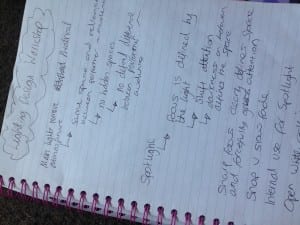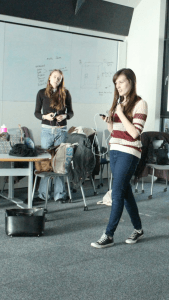Today in rehearsal, Emmie and I sat down and went through the script talking about possible ideas for lighting each scene. I decided that the lighting should be kept fairly simple, using spotlights to define important moments or to separate action. My only concern at the moment is that the lighting is quite repetitive, however as we are still staging some scenes this is likely to change.
Tag: clare owen
Meeting with Darren and Lighting Workshop
Following our first production meeting, LPAC’s stage manager Darren Page invited Emmie and I for an informal chat about lighting and sound. During this talk, I believe the most important advice that Darren gave to us about stage lighting was that the lighting used for each scene had to be used for a reason. Following this talk we were invited to attend a lighting workshop that Darren would be running the following week.
The workshop ran by Darren and his colleague Mark was incredibly helpful. They discussed how different types of light created different types of effects and how that had an impact on the atmosphere of a scene. For example if a scene is lit using ‘top lights’ a sinister atmosphere is created as when an audience ‘cannot see someone’s eyes, it creates a feeling of distrust’ (Page 2015). Darren and Mark also spoke about how the audiences’ focus is defined by the light, in the sense that a lit area on a dark stage indicates to the audience that is where they must look. This is supported by Drew Campbell who states ‘lighting also discriminates between where the show is happening and where it is not’ (2004, p7)
Moving forward from this I intend to sit out of a few rehearsals and make notes on what types of lighting I should use for each scene. I will of course be in conversation with our director Tamsyn to agree on what mood she wants to create for each scene and with Emmie to check that my designs can be applied practically.
(Photo by Clare Owen 2015)
WORKS CITED
Campbell, D. (2004) Technical Theater for Nontechnical People. Second Edition. New York: Allworth Press
Owen, C. (2015) Photo of Lighting Workshop Notes
Page, D. (2015) Lighting Workshop. [workshop] Lincoln, 20 April.
Headphone Verbatim
This week, verbatim theatre was experimented with in rehearsal. ‘The term verbatim refers to the origins of the text spoken in the play. The words of real people…’ (Hammond and Steward 2008, p9). The particular form of verbatim we used was Headphone Verbatim, first pioneered by director Mark Wing-Davey in his Drama without Paper workshop in 2001 (Oades, 2014).
In a previous rehearsal we had been recorded answering interview style questions about what it meant to be an adult to us and how we had felt at various milestones in our life, for example going off to university. During this week’s rehearsal we each chose a recording that was not our own, and spent 10 minutes listening repeatedly to it through headphones. Then we attempted to speak the words of our subject at the same time as the recording. We did not attempt to copy the exact voice or accent of the person but tried to repeat the words in the same tone, dialect and context as they were first said. Some members of the group performed this in front of the group and it was interesting to hear imperfect but ‘real’ speech. Often there were a lot of pauses, ‘um’s’ and ‘err’s’ as well as regional ‘slang’, which is a contrast to what we as audiences usually hear in a theatrical piece and what we as actors usually perform.
(All photos by Oliver Samuals)
Of course with the use of ‘real’ people’s words there will always be ethical considerations to take in to account. As Janet Gibson details ‘Verbatim theatre uses the narratives of people who may perceive that their life stories and their identities are coextensive.’ (n.d, p10) Therefore we will have to be very particular about how we use the words of others in our piece and ensure we do not take them out of or distort the original context in which they were said, as this will not only be a misrepresentation of the words but also of the person who said them.
Hello, Goodbye & Happy Birthday by Roslyn Oades is a headphone verbatim piece which looks at a similar topic as our own performance “the threshold from child into adulthood, as well as, from self-sufficient adult into aged care dependency” (Oades, 2014). Although Hello, Goodbye & Happy Birthday focuses more on the “bookends of adult life” (Oades 2014). Aside from the use of headphone verbatim, Oades also used theatrical contrast to create Hello, Goodbye & Happy Birthday, for example some of the younger actors performed the audio created from the words of an elderly care home resident. Oades decided to use this technique of ‘ mismatching voices and bodies to explore perceptions of ageing and visibility’ (2014). Similarly in Monkey Bars by Unicorn Theatre this juxtaposition of voice and body is used as ‘adults playing adults’ speak the words of children (Unicorn Theatre, 2013). By creating this contrast between voice and body, examinations into identity and perspectives can be achieved. This is particularly relevant with our topic of adulthood as we can begin to examine if our perspectives of what it is to be an adult ‘grown up’ alongside us.
(Hello, Goodbye & Happy Birthday trailer, from Youtube 2014)
WORKS CITED
Gibson, J. (n.d) Saying it Right: Creating Ethical Verbatim Theatre. Macquarie University Faculty of Arts. Available from http://arts.mq.edu.au/documents/hdr_journal_neo/neoJanet2011_2.pdf [Accessed 26/02/15]
Hammond, W. and Steward, D. (2008) Verbatim Verbatim. London: Oberon.
Oades, R. (2014) Hello, Goodbye & Happy Birthday. [online] Available from http://www.roslynoades.com/HelloGoodbye.html [Accessed 26/02/15]
Oades, R (2014) Hello, Goodbye & Happy Birthday – behind the scenes [online video] Available from https://www.youtube.com/watch?v=gpE1OQX8wnY [Accessed 26/02/15]
Oades, R. (2014) Hello, Goodbye & Happy Birthday – trailer. [online video] Available from https://www.youtube.com/watch?v=gpE1OQX8wnY [Accessed 26/02/15]
Samuals, O. (2015) Photo of Headphone Verbatim in Rehearsal
Unicorn Theatre (2013) Monkey Bars [online] Available from https://www.unicorntheatre.com/whatson/38/monkey-bars [Accessed 26/02/15]



